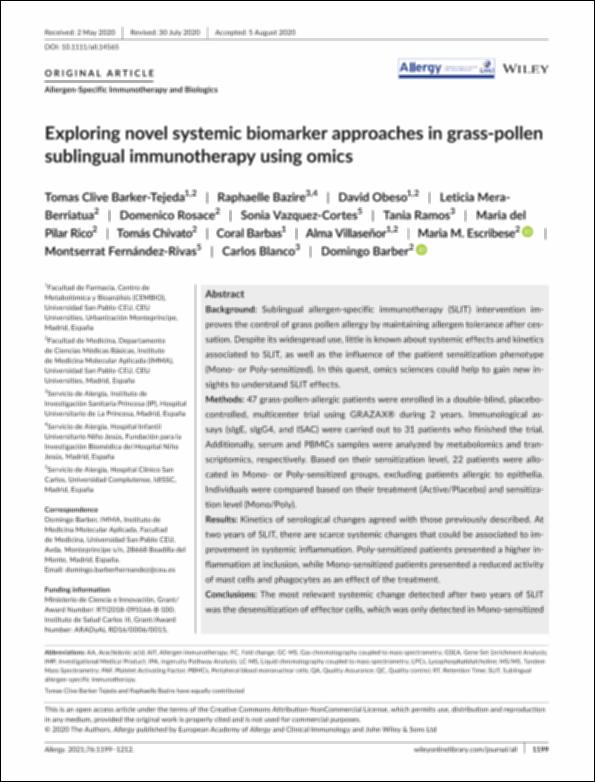Por favor, use este identificador para citar o enlazar este ítem:
http://hdl.handle.net/10637/13004Exploring novel systemic biomarker approaches in grass-pollen sublingual immunotherapy using omics.
| Título : | Exploring novel systemic biomarker approaches in grass-pollen sublingual immunotherapy using omics. |
| Autor : | Chivato Pérez, Tomás Barbas Arribas, Coral. Villaseñor Solis, Alma Cristina Barker Tejeda, Tomas Clive Escribese Alonso, María Marta Barber Hernández, Domingo Obeso Montero, David |
| Materias: | Biomarkers.; Metabolomics.; Sublingual.; Immunotherapy.; Transcriptomics.; Respiratory allergy |
| Resumen : | Background: Sublingual allergen-specific immunotherapy (SLIT) intervention improves the control of grass pollen allergy by maintaining allergen tolerance after cessation. Despite its widespread use, little is known about systemic effects and kinetics associated to SLIT, as well as the influence of the patient sensitization phenotype (Mono- or Poly-sensitized). In this quest, omics sciences could help to gain new insights to understand SLIT effects. Methods: 47 grass-pollen-allergic patients were enrolled in a double-blind, placebocontrolled, multicenter trial using GRAZAX® during 2 years. Immunological assays (sIgE, sIgG4, and ISAC) were carried out to 31 patients who finished the trial. Additionally, serum and PBMCs samples were analyzed by metabolomics and transcriptomics, respectively. Based on their sensitization level, 22 patients were allocated in Mono- or Poly-sensitized groups, excluding patients allergic to epithelia. Individuals were compared based on their treatment (Active/Placebo) and sensitization level (Mono/Poly). Results: Kinetics of serological changes agreed with those previously described. At two years of SLIT, there are scarce systemic changes that could be associated to improvement in systemic inflammation. Poly-sensitized patients presented a higher inflammation at inclusion, while Mono-sensitized patients presented a reduced activity of mast cells and phagocytes as an effect of the treatment. Conclusions: The most relevant systemic change detected after two years of SLIT was the desensitization of effector cells, which was only detected in Mono-sensitized patients. This change may be related to the clinical improvement, as previously reported, and, together with the other results, may explain why clinical effect is lost if SLIT is discontinued at this point. |
| Descripción : | Artículo en colaboración con: Raphaelle Bazire, David Obeso, Leticia Mera Berriatua, Domenico Rosace, Sonia Vazquez Cortes, Tania Ramos; Maria del Pilar Rico, Tomás Chivato, Coral Barbas, Alma Villaseñor, Maria M. Escribese, Montserrat Fernández Rivas, Carlos Blanco, Domingo Barber En: Allergy. e-ISSN 1398-9995 2021, 76 : 1199-1212 |
| URI : | http://hdl.handle.net/10637/13004 |
| Derechos: | http://creativecommons.org/licenses/by-nc-nd/4.0/deed.es |
| Fecha de publicación : | 16-sep-2021 |
| Centro : | Universidad San Pablo-CEU |
| Aparece en las colecciones: | Facultad de Farmacia |
Los ítems de DSpace están protegidos por copyright, con todos los derechos reservados, a menos que se indique lo contrario.


